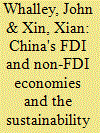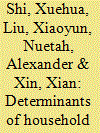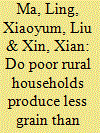|
|
|
Sort Order |
|
|
|
Items / Page
|
|
|
|
|
|
|
| Srl | Item |
| 1 |
ID:
093847


|
|
|
|
|
| Publication |
2010.
|
| Summary/Abstract |
This paper presents and assesses of the contribution of inward FDI to China's recent rapid economic growth using a two stage growth accounting approach. Recent econometric literature focuses on testing whether Chinese growth depends on inward FDI rather than measuring the contribution. Foreign Invested Enterprises (FIEs), often (but not exclusively) are joint ventures between foreign companies and Chinese enterprises, and can be thought of as forming a distinctive subpart of the Chinese economy. These enterprises account for over 50% of China's exports and 60% of China's imports. Their share in Chinese GDP has been over 20% in the last two years, but they employ only 3% of the workforce, since their average labor productivity exceeds that of Non-FIEs by around 9:1. Their production is more heavily for export rather than the domestic market because FIEs provide access to both distribution systems abroad and product design for export markets. Our decomposition results indicate that China's FIEs may have contributed over 40% of China's economic growth in 2003 and 2004, and without this inward FDI, China's overall GDP growth rate could have been around 3.4 percentage points lower. We suggest that the sustainability of both China' export and overall economic growth may be questionable if inward FDI plateaus in the future.
|
|
|
|
|
|
|
|
|
|
|
|
|
|
|
|
| 2 |
ID:
094661


|
|
|
|
|
| Publication |
2010.
|
| Summary/Abstract |
This article uses multivariate regression and decomposition analyses to assess household income mobility determinants and their contributions to income mobility in rural China from 1989 to 2006. The findings indicate that households with lower initial income level, higher share of wage income, higher educational level of household members, larger number of non-agricultural employed household members and younger heads are more mobile. Moreover, besides initial income, change in the share of wage income, change in the share of non-agricultural employed household members, and change in average year of education of household members are the most important factors that account for income mobility. These findings necessitate more emphasis on policies that promote non-agricultural employment and education to enhance household income mobility in rural China.
|
|
|
|
|
|
|
|
|
|
|
|
|
|
|
|
| 3 |
ID:
124982


|
|
|
|
|
| Publication |
2013.
|
| Summary/Abstract |
China's poor rural households produce substantially less grain compared with non-poor rural households. The present paper applies a decomposition approach and uses China's rural household survey data to investigate the causes of this grain output gap. The paper first compares the grain output gap between poor and non-poor rural households, and then decomposes the gap into differences in yield and area sown. The results indicate that the gap in grain output mainly results from differences in the amount of inputs used in production. Differences in the number of labor days and the level of intermediate inputs account for 13.6 and 47.5 percent of the gap, respectively. Poor rural households are also less efficient in their use of intermediate inputs, which contributes to 13.2 percent of the gap. However, the efficiency of poor households' labor days reduces the gap by 7.2 percent, while agricultural physical capital, household head education and agricultural training have no substantial impact on the household grain output gap.
|
|
|
|
|
|
|
|
|
|
|
|
|
|
|
|
| 4 |
ID:
113681


|
|
|
|
|
| Publication |
2012.
|
| Summary/Abstract |
This article retests the separability of China's rural households in light of growing doubt about the sustainability of high economic growth in China. If a household's production decisions are "separable" from the household's consumption decisions, generally this suggests there is no surplus labor. Many scholars aver that China's surplus rural labor has spurred rapid economic growth, but concerns have arisen as to whether China still has surplus labor available. We investigate this issue using rural household panel data from 1993 to 2009 The regression results confirm that households in rural China have progressed from being non-separable to separable. The estimation results for both the entire country and regions reject the separability hypothesis before 2004 but fail to reject the hypothesis after 2004 (with the exception of the central region). These results suggest that China's surplus labor supply is dwindling, especially in the eastern and the western regions. The sustainability of China's high economic growth is questionable in the absence of a large reservoir of surplus rural labor.
|
|
|
|
|
|
|
|
|
|
|
|
|
|
|
|
| 5 |
ID:
154452


|
|
|
|
|
| Summary/Abstract |
The Chinese Government has increased its focus on expanding farm scale to promote agricultural development since 2010. A series of favorable polices has been adopted to support large-scale farming. Using a multivariate probit model and 2015 and 2016 rural household survey data, the present paper examines the factors that influence small farmers' decision to become large-scale farmers. The empirical regression results suggest that the decision to become a large-scale farmer is significantly influenced by household human capital, cooperative membership, marketing channels, land-transfer contracts and government policies. However, the influence of these factors differs with respect to becoming large-scale grain and non-grain farmers. These results imply that policy tools should target these factors and the appropriate group of small-scale farmers. Generally, both central and local governments should promote large-scale farming by enhancing rural households' human capital, improving marketing channels and providing agricultural social services, as well as encouraging returning migrant workers to engage in large-scale farming.
|
|
|
|
|
|
|
|
|
|
|
|
|
|
|
|
|
|
|
|
|